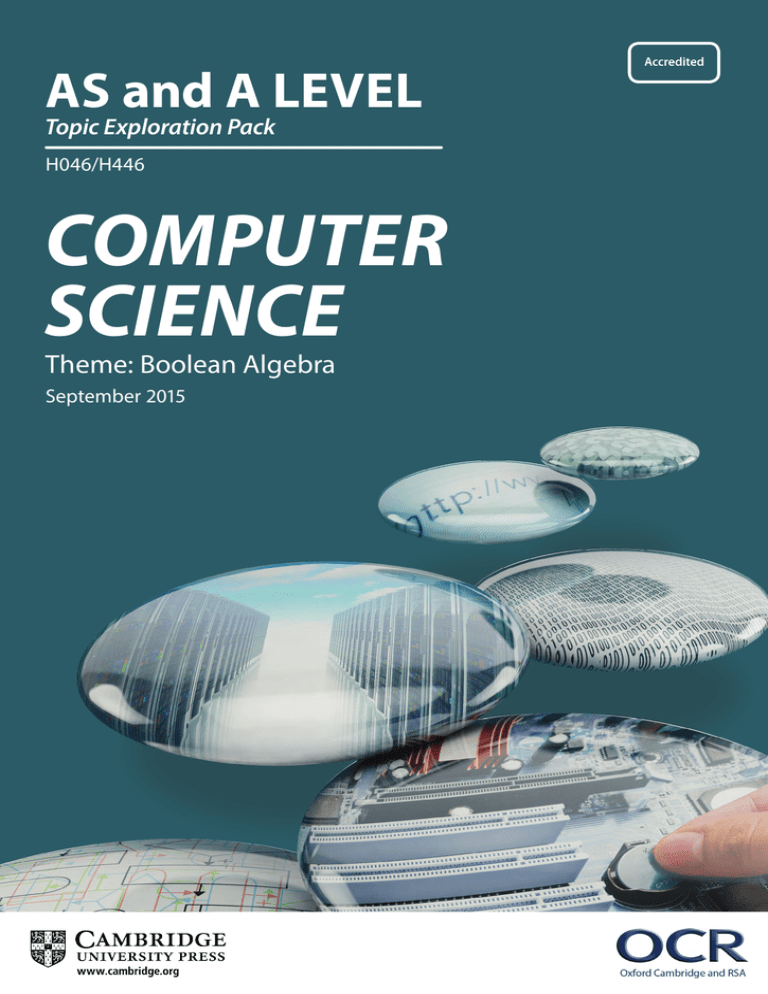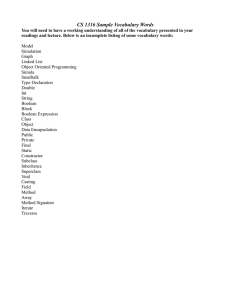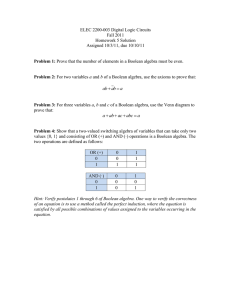
AS and A LeveL
Topic Exploration Pack
H046/H446
Computer
SCienCe
Theme: Boolean Algebra
September 2015
We will inform centres about any changes to the specification. We will also publish changes on our website. The latest version of our specification will always be the one on our website (www.ocr.org.uk) and this may differ from printed versions. Copyright © 2015 OCR. All rights reserved.
Copyright OCR retains the copyright on all its publications, including the specifications. However, registered centres for OCR are permitted to copy material from this specification booklet for their own internal use.
Oxford Cambridge and RSA Examinations is a Company Limited by Guarantee. Registered in England. Registered company number 3484466.
Registered office: 1 Hills Road
Cambridge
CB1 2EU
OCR is an exempt charity.
A Level Computer Science
Topic Exploration Pack
Contents
Contents ......................................................................................................................................... 3
Boolean Algebra ............................................................................................................................. 4
Define Problems Using Boolean Logic ............................................................................................ 4
Activity 1 ......................................................................................................................................... 4
Activity 2 ......................................................................................................................................... 4
Using Logic Gate Diagrams and Truth Tables................................................................................. 7
The Logic Associated with D-Type Flip-Flops, Half and Full Adders................................................ 7
Student Sheets ............................................................................................................................. 10
This Topic Exploration Pack should accompany the OCR resource ‘Boolean Algebra’ learner activities,
which you can download from the OCR website.
This activity offers an
opportunity for English
skills development.
Version 1
3
A Level Computer Science
Topic Exploration Pack
Boolean Algebra
Define Problems Using Boolean Logic
A good approach for teaching Boolean logic would be to start with the idea of logic gates and truth tables
as these are concepts that can be easily covered and can therefore be used to build student confidence
with the new material.
Activity 1
Worksheet 1 is given as an introduction to how one might define problems using Boolean algebra.
Students could have a go at filling this worksheet in to get used to this style of logic.
Activity 2
You could get students to draw out truth tables for each logic gate, and then get students to combine two
logic gates together, making the truth table for each. Worksheet 2 is given as a guide to Boolean algebra.
For example, the truth table for XOR, NAND and NOR is given below.
A
B
A⊕ B
A. B
A. B
A+B
A+B
0
0
0
0
1
0
1
1
0
1
0
1
1
0
0
1
1
0
1
1
0
1
1
0
1
0
1
0
Manipulate Boolean expressions using Karnaugh maps to simplify the solution.
Manipulating Boolean expressions will require knowledge of the section on using rules to simplify
statements in Boolean algebra.
Version 1
4
A Level Computer Science
Topic Exploration Pack
In addition to manipulating and simplifying the Boolean equation and using truth tables, one other way of
simplifying Boolean expressions is to use a method called Karnaugh map.
The first thing you need to do for a Karnaugh map is enter 1’s for all cases where your Boolean equation
is True.
This is what a simple Karnaugh map would look like for the equation Q = 𝐴̅. 𝐵 + 𝐴. 𝐵
Version 1
5
A Level Computer Science
Topic Exploration Pack
This guide found at the CAS resources section deals with what happens if we have three or four
variables in our Karnaugh map:
http://community.computingatschool.org.uk/resources/567
Use the following rules to derive or simplify statements in Boolean algebra: De Morgan’s Laws,
distribution, association, commutation, double negation.
Manipulating Boolean expressions in a lot of ways is like manipulating algebraic equations. Most of the
rules are the same, but some will take some getting used to. In the same way, as 4 + 2 can be replaced
by 6, there are similar sorts of rules in Boolean algebra, for example A.A = A.
Once you have got to know the rules, the most tricky thing to develop is the ability to spot where different
rules can be applied. It may help in some instances where different letters are being used to replace
them with the ones that you are used to. The examples below use A, B and C, although you may be
faced with a question that uses different letters, and some students can find this hard to grasp.
Tautology
A.A = A
A+A = A
A+𝐴̅ = 1
A.𝐴̅ = 0
1+A = 1
1.A = A
0+A = A
0.A = 0
Commutative
AB = BA
A+B = B+A
Associative
(A+B)+C = A+(B+C)
A.(B.C) = (A.B).C
Distributive
A.(B+C) = (A.B)+(A.C)
A+(B.C) = (A+B).(A+C)
A series of helpful worksheets and suggestions for this can be found at:
http://community.computingatschool.org.uk/resources/1788
Version 1
6
A Level Computer Science
Topic Exploration Pack
Using Logic Gate Diagrams and Truth Tables.
Logic gates would be a good topic to start this part of the specification as they are the fundamental
building blocks when moving onto Boolean algebra.
From knowing simple logic gates, we can then go on to understanding how to construct truth tables for
these fundamental symbols. These are easy for students to grasp what is going on. Please see
Worksheet 2 for a full run down.
You may choose to combine practice examples and questions with constructing the logic circuits on a
simulator such as ‘Logic gate simulator’ by Steve Kollmansberger at.
http://www.kolls.net/gatesim/
The Logic Associated with D-Type Flip Flops, Half and Full Adders
After studying Boolean addition, students should be able to appreciate the purpose of the half and full
adder circuits. The purpose of a half adder is to add together two 1-bit binary numbers and outputs the
sum and a carry bit, whereas a full adder takes in 3 inputs. The full adder is simply two half adders
combined with an OR gate.
Some nice animations and truth tables which illustrate what is going on in a half adder and a full adder
circuit can be found at:
http://isweb.redwoods.edu/INSTRUCT/CalderwoodD/diglogic/half-add.htm
In general terms, a flip-flop is an electronic component that has two stable states.
A D-type flip flop is an electronic component that accepts two inputs. One is the input ‘D’ and the clock.
There are two outputs, Q and 𝑄. 𝑄 is simply the inverse value of Q (as we already know from Boolean
algebra!).
The input at D (let’s say the current output at Q is 0 and D is 1) does not cause a change right away, but
waits for a rising clock edge (see diagram below).
Version 1
7
A Level Computer Science
Topic Exploration Pack
D
𝑄
Q
Q
D
Q(t+1)
0
0
0
0
1
1
1
0
0
1
1
1
Clock
D
Q
In this waveform diagram, there are a few things to notice that help us with understanding how a D-type
flip-flop works.
See how D rises, but yet Q doesn’t change until the ‘rising edge’ of the clock pulse.
Also notice how D rises and falls and then rises again. During this period Q doesn’t change. That is
because Q will only change on the rising clock edge.
At the second clock rising edge, we can see that D is now low, which forces Q to be low.
Version 1
8
A Level Computer Science
Topic Exploration Pack
Teacher preparation
In terms of teacher preparation the best thing to do would be to firstly have a good grasp of the subject
matter yourself and the specific methodologies, hints and tricks that fit your experience of what makes
things easier to understand. A guide – Worksheet 1– has been provided for use by both the teacher and
students to get used to the key concepts in Boolean algebra quickly.
A list of tasks that you may want to get familiar with in order are:
1. Understand what a logic gate is and why we use them
2. How to write down simple Boolean equations (see Worksheet 1)
3. How to construct truth tables for simple 1 or 2 gate logic setups (see Worksheets 2 and 3). At
this point you may want to test these out using software, or if you are really adventurous,
constructing the actual circuits.
4. Simple Boolean identities and their proof using truth tables (see Worksheet 2)
5. More complex Boolean laws (Commutation, Association, Distribution, Double negation and De
Morgan’s). Prove these using truth tables.
6. Be able to use a combination of these rules to simplify increasingly complex Boolean equations.
Prove that these are correct using truth tables.
7. Be able to draw out logic circuit diagrams based on a Boolean equation and vice versa (see
Worksheet 1 of the delivery guide).
8. Understand how Karnaugh maps can also be used to simplify Boolean logic. Again, you can
check whether you are correct by manipulating the algebra, creating truth tables and checking
via software.
9. Understand the concepts behind how half adders, full adders and flip-flops work.
You may choose to get some of the software installed in advance (or test the web-based versions to see
if they work properly) and familiarise yourself with how these operate.
It is then a case of getting sufficient worksheets prepared with examples and enough variety to stretch
the most able students. Of course, there are many examples available online too.
Version 1
9
A Level Computer Science
Topic Exploration Pack
Student Sheets
Worksheet 1 – Defining problems
This worksheet provides a basis for relating Boolean algebra to everyday life. You will first need to cover
the key terminology and symbols associated with this sort of algebra, however, as it is quite different
from what students would be used to GCSE mathematics.
Worksheet 2 – Boolean algebra guide
The Boolean algebra guide aims to give a walkthrough of each law and proof using truth tables. Rather
than students being told what a certain law is, they can prove it using the truth table and this will help
them find the activity far more convincing.
Fully worked examples are given at the end of the guide that students can try to work out.
Worksheet 3 – Examples of using logic gates
This worksheet will get students thinking about how logic gates can be combined to give different
outcomes. The activity leads on to creating truth tables for each series of gates.
We’d like to know your view on the resources we produce. By clicking on the ‘Like’ or ‘Dislike’
button you can help us to ensure that our resources work for you. When the email template pops
up please add additional comments if you wish and then just click ‘Send’. Thank you.
If you do not currently offer this OCR qualification but would like to do so, please complete the
Expression of Interest Form which can be found here: www.ocr.org.uk/expression-of-interest
OCR Resources: the small print
OCR’s resources are provided to support the teaching of OCR specifications, but in no way constitute an endorsed teaching method that is required by the Board, and the decision to
use them lies with the individual teacher. Whilst every effort is made to ensure the accuracy of the content, OCR cannot be held responsible for any errors or omissions within these
resources.
© OCR 2015 - This resource may be freely copied and distributed, as long as the OCR logo and this message remain intact and OCR is acknowledged as the originator of this work.
OCR acknowledges the use of the following content: Thumbs up and down icons: alexwhite/Shutterstock.com
Please get in touch if you want to discuss the accessibility of resources we offer to support delivery of our qualifications: resources.feedback@ocr.org.uk
Version 1
10
OCR customer contact centre
General qualifications
Telephone 01223 553998
Facsimile 01223 552627
Email general.qualifications@ocr.org.uk
For staff training purposes and as part of our quality assurance programme your call may be recorded or monitored.
©OCR 2015 Oxford Cambridge and RSA Examinations is a Company Limited by Guarantee. Registered in England.
Registered office 1 Hills Road, Cambridge CB1 2EU. Registered company number 3484466. OCR is an exempt charity.




